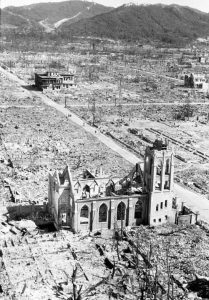Documenting Hiroshima of 1945: December 23, Christmas service held at Nagarekawa Church
Dec. 24, 2024
“Sound of bells is true comfort and encouragement”
by Maho Yamamoto, Staff Writer
On Sunday, December 23, 1945, the Hiroshima Nagarekawa Church, located in the area of Kaminagarekawa-cho (in Hiroshima City’s Naka Ward), held a Christmas service. The church building, located at a distance of around 900 meters from the hypocenter, had been destroyed in the atomic bombing, except for its outer walls. With that, the venue for the service was a church member’s home behind Ushita National School (present-day Ushita Elementary School, in the city’s in Higashi Ward) that the church minister Kiyoshi Tanimoto, who died in 1986 at the age of 77, had leased as a church “office.” Taking that opportunity, the church resumed the holding of regular congregations, which had been suspended after the bombing.
Before the Christmas service, the church began to issue a “church newsletter.” It is thought that Mr. Tanimoto handwrote the newsletter’s original script, which was then mimeographed on to postcards. He would walk around distributing the newsletter while checking on the well-being of his church congregants. The newsletter dated December 13 announced, “Since the air raid on August 6, we have suspended various church gatherings. But with the opportunity presented by the Christmas service this coming Sunday, December 23, we will resume the regular meetings.” The newsletter also reported on the whereabouts of 23 church members.
The newsletter dated December 16 emphasized that, “The sound of Christmas bells is true comfort and encouragement to our brethren, who are lost, stunned, and have fallen into despair after our loss. The eternal hope of Japan after the defeat in war resides in Christmas.” The newsletter indicated that following the worship service at 10 a.m., a celebratory gathering was scheduled from 1:30 p.m., and in an additional note that, “with invitation to occupation troop members.” The church had been established in 1887. A total of 75 of its congregants died in the atomic bombing. After experiencing the bombing at the home of his acquaintance in the area of Koi (in Hiroshima’s present-day Nishi Ward), Mr. Tanimoto engaged in relief efforts at such locations as Sentei Garden (present-day Shukkeien Garden), which was overwhelmed by the many wounded.
On that day of December 23, about 50 people joined the service, in which Mr. Tanimoto delivered a sermon and church members performed Christmas carols. Reflecting back on that congregation, Mareo Mukai, 64, the church’s current minister, remarked, “I think they must have cherished the peace in which they could worship freely after the war had ended. The Christmas of 1945 also had significant meaning for the church.”
(Originally published on December 24, 2024)
by Maho Yamamoto, Staff Writer
On Sunday, December 23, 1945, the Hiroshima Nagarekawa Church, located in the area of Kaminagarekawa-cho (in Hiroshima City’s Naka Ward), held a Christmas service. The church building, located at a distance of around 900 meters from the hypocenter, had been destroyed in the atomic bombing, except for its outer walls. With that, the venue for the service was a church member’s home behind Ushita National School (present-day Ushita Elementary School, in the city’s in Higashi Ward) that the church minister Kiyoshi Tanimoto, who died in 1986 at the age of 77, had leased as a church “office.” Taking that opportunity, the church resumed the holding of regular congregations, which had been suspended after the bombing.
Before the Christmas service, the church began to issue a “church newsletter.” It is thought that Mr. Tanimoto handwrote the newsletter’s original script, which was then mimeographed on to postcards. He would walk around distributing the newsletter while checking on the well-being of his church congregants. The newsletter dated December 13 announced, “Since the air raid on August 6, we have suspended various church gatherings. But with the opportunity presented by the Christmas service this coming Sunday, December 23, we will resume the regular meetings.” The newsletter also reported on the whereabouts of 23 church members.
The newsletter dated December 16 emphasized that, “The sound of Christmas bells is true comfort and encouragement to our brethren, who are lost, stunned, and have fallen into despair after our loss. The eternal hope of Japan after the defeat in war resides in Christmas.” The newsletter indicated that following the worship service at 10 a.m., a celebratory gathering was scheduled from 1:30 p.m., and in an additional note that, “with invitation to occupation troop members.” The church had been established in 1887. A total of 75 of its congregants died in the atomic bombing. After experiencing the bombing at the home of his acquaintance in the area of Koi (in Hiroshima’s present-day Nishi Ward), Mr. Tanimoto engaged in relief efforts at such locations as Sentei Garden (present-day Shukkeien Garden), which was overwhelmed by the many wounded.
On that day of December 23, about 50 people joined the service, in which Mr. Tanimoto delivered a sermon and church members performed Christmas carols. Reflecting back on that congregation, Mareo Mukai, 64, the church’s current minister, remarked, “I think they must have cherished the peace in which they could worship freely after the war had ended. The Christmas of 1945 also had significant meaning for the church.”
(Originally published on December 24, 2024)









